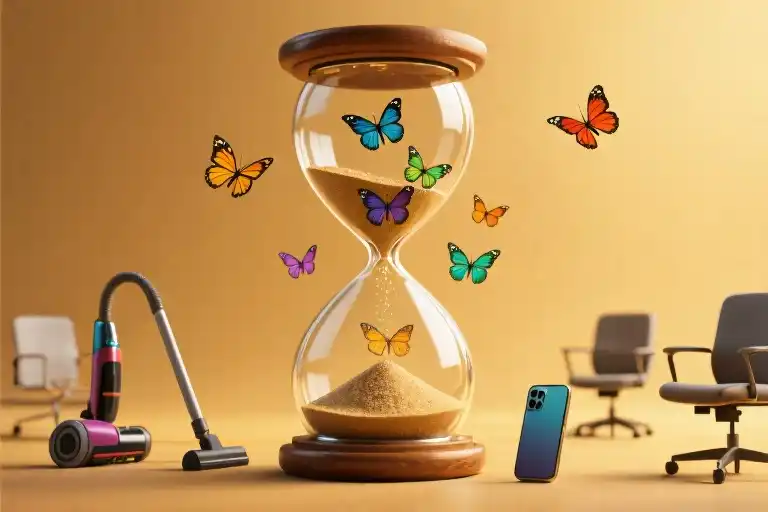Monday morning arrives with that familiar surge of optimism. I open my planner to a crisp new page, carefully block out time slots for writing, research, client calls, and even that online course I’ve been meaning to take. The colored markers make it look so achievable—just eight neat rectangles of productivity. Fast forward to Friday afternoon, and half those boxes remain untouched while others bleed into each other like watercolor mistakes. The planner that promised order now mocks me with its cheerful emptiness.
This isn’t just poor time management. For those of us with ADHD, it’s a neurological reality called time blindness—the inability to accurately estimate how long tasks will take, paired with an optimism bias that whispers “this time will be different.” We don’t just struggle with distractions; we wage war against our own brains’ faulty GPS system that always says “10 minutes to destination” when we’re actually hours away.
Cal Newport’s definition of deep work cuts through this fog: “To produce at your peak level you need to work for extended periods with full concentration on a single task free from distraction.” That single-task focus is the antidote to our scattered minds, but standard productivity advice crumbles when applied to ADHD brains. We don’t need more discipline; we need different rules—not just for working deeply, but for surviving the collision between our vibrant, chaotic minds and a world that rewards linear focus.
The irony stings: the very traits that make ADHD brains creative problem-solvers (rapid idea association, hyperfocus bursts) become liabilities in cultivating sustained concentration. Traditional deep work methods assume a neurotypical operating system, leaving those of us with different mental wiring to constantly force-restart our productivity like glitchy computers. But what if we stopped fighting our neurology and started designing deep work practices that actually work with our brains?
When ADHD Meets Deep Work
There’s a particular kind of Monday morning optimism that lives in my ADHD brain. Notebook open, colored pens ready, I’ll map out a perfect week: three client projects drafted by Wednesday, that online course completed by Friday afternoon, and yes, absolutely time for yoga every morning. By Thursday, the untouched course modules and half-finished documents tell a different story – one where time behaved differently than my brain predicted.
This isn’t just poor planning. ADHD time blindness creates a fundamental mismatch between how we experience time passing and how it actually unfolds. That report I swore would take two hours? It’s now hour four and I’m still tweaking the introduction. The phenomenon is well-documented: studies suggest ADHD adults typically underestimate task duration by 30-40%, while overestimating what they can accomplish in a given day by nearly 60%.
What makes this especially cruel is how it interacts with deep work. The very practice requiring sustained focus becomes sabotaged by our own neurology. We enter a vicious cycle: optimistic planning → interrupted execution → frustration → more ambitious planning to ‘make up for lost time.’ I’ve lost count of afternoons where I scheduled back-to-back deep work blocks, only to spend the first 25 minutes of each session just recovering from the mental whiplash of task-switching.
The cruel joke is that ADHD brains crave deep work’s rewards. That hyperfocus state we occasionally stumble into? It’s our nervous system’s proof that sustained attention is possible – just not on demand. The key lies in restructuring deep work around how our brains actually function, rather than forcing them into neurotypical molds. It starts with recognizing that our time blindness isn’t a moral failing, but a neurological difference requiring different tools.
Physical timers became my first breakthrough. Digital clocks abstract time; watching minutes tick away on a screen does nothing for my brain’s impaired time perception. But the tactile click of a mechanical kitchen timer winding down creates sensory anchors my brain can track. Setting it for 25% longer than my initial time estimate counteracts the optimism bias. The audible countdown forces awareness of time’s passage in a way my prefrontal cortex struggles to manage alone.
This isn’t about lowering standards, but about matching methods to neurology. When I stopped fighting my brain’s time perception and started working with it, something unexpected happened. Those overambitious Monday plans? They still exist, but now get filtered through Friday’s hard-won wisdom about how my attention actually unfolds. The deep work sessions became shorter but more frequent, respecting my brain’s natural rhythm rather than demanding marathon focus it couldn’t deliver.
The Dual Scientific Foundations of Deep Work
The concept of deep work doesn’t exist in a vacuum. It stands on the shoulders of two distinct yet complementary psychological frameworks that explain why focused work feels so radically different from our usual scattered efforts. Understanding these foundations helps adapt the practice for neurodivergent minds.
Cal Newport’s contribution lies in framing attention as our most valuable and endangered resource in the digital age. His research at Georgetown revealed what he calls “the attention capital principle” – that high-value work requires long stretches of uninterrupted focus, a commodity becoming rarer than vintage typewriters in Silicon Valley. This scarcity isn’t just about willpower; our brains physically reconfigure when switching tasks, with studies showing it takes an average of 23 minutes to fully regain deep focus after an interruption.
Meanwhile, Mihaly Csikszentmihalyi’s flow state theory, developed through decades of observing artists and athletes, describes the optimal experience of complete absorption in an activity. The Hungarian psychologist mapped what he called \”the flow channel\” – that narrow psychological space where challenge level perfectly matches skill level. Too easy, we get bored; too hard, we panic. Flow occurs in that sweet spot where time distorts and self-consciousness evaporates.
For ADHD brains, these theories intersect in fascinating ways. Where Newport emphasizes deliberate structure to combat distraction, Csikszentmihalyi focuses on the organic emergence of engagement. The magic happens when we borrow from both – creating conditions where flow can occur naturally within protected time blocks.
Consider the flow channel as a river. Neurotypical minds might navigate it with moderate effort, while ADHD brains often feel like they’re simultaneously fighting rapids and drought. Deep work provides the containment banks that keep us from spilling over into distraction, while flow theory explains why certain tasks (usually those tapping into our core competencies) make focus feel effortless rather than forced.
The practical takeaway? Effective deep work for neurodivergent thinkers means:
- Structuring time like Newport recommends (external scaffolding)
- Choosing tasks that naturally induce flow (internal motivation)
- Recognizing when to switch between focused effort and restorative breaks
This dual foundation explains why some productivity systems fail ADHD thinkers – they often focus solely on external constraints without considering internal engagement factors. The most sustainable deep work happens when we honor both the need for structure and the neurological reality of how our attention actually functions.
The ADHD-Friendly Deep Work Rules
My kitchen timer sits on my desk like an ancient relic. Its mechanical ticking sounds almost judgmental as I stare at the half-written email, the unfinished spreadsheet, and the three browser tabs mocking my attempt at single-tasking. This is what happens when an ADHD brain meets deep work – good intentions colliding with neurological reality.
Rule 1: The Single Task Ultimatum
Deep work begins with surrender. Not to distraction, but to the radical acceptance that our brains weren’t built for parallel processing. That email draft? It gets the full 25-minute timer. The spreadsheet? It waits its turn like everyone else.
The science is simple: ADHD brains pay an extraordinary switching cost. One study showed task-switching consumes 40% more time for neurodivergent individuals. When we commit to single-tasking, we’re not being lazy – we’re accounting for our cognitive taxes.
Try this now:
- Choose one shallow task (replying to messages doesn’t count)
- Set a visible timer for half your estimated time (yes, halve it)
- When the urge to switch hits, write the distraction on sticky note – then continue
Rule 2: Time Made Physical
Digital clocks disappear into screens, but a ticking kitchen timer demands attention. The physical act of winding it creates a ritual, while its audible ticks provide rhythmic feedback. For visual learners, try hourglasses – watching sand fall makes abstract time suddenly tangible.
ADHD specialist Dr. Russell Barkley calls this ‘externalizing time’ – taking what our brains struggle to track internally and making it concrete. My $8 mechanical timer works better than any app because I can’t ignore its persistent clicking.
Rule 3: Sensory Anchors
The right scent or sound can become a Pavlovian trigger for focus. I use peppermint oil (research shows it enhances alertness) and the same instrumental playlist for deep work sessions. Over time, this sensory combination tells my brain: ‘It’s time to tunnel in.’
Neuroscience explains why this works: consistent environmental cues help ADHD brains transition between states. The key is specificity – reserve these triggers exclusively for deep work.
Rule 4: The Distraction Ledger
Here’s the paradox: trying to suppress distractions amplifies them. Instead, keep a dedicated notebook labeled ‘Later’ – when intrusive thoughts about laundry or Wikipedia rabbit holes appear, jot them down ceremoniously. This acknowledgment satisfies the ADHD brain’s craving for novelty without derailing focus.
Clinical psychologist Dr. Ned Hallowell recommends treating distractions like uninvited party guests: ‘Thank them for coming, then show them the door.’
Rule 5: Energy Banking
ADHD energy levels fluctuate unpredictably. Schedule demanding tasks during personal peak hours (mine are 10-12am), reserving afternoons for administrative work. This ‘low battery mode’ acknowledges our finite cognitive resources rather than fighting them.
Track your energy patterns for a week. You’ll likely find predictable ebbs and flows – plan deep work sessions accordingly. Resistance decreases when we work with our neurology rather than against it.
When Rules Meet ADHD Brains: Real-World Experiments
The theory sounds clean on paper. Single-tasking. Time-blocking. Sensory anchors. But how do these rules actually play out inside neurodivergent minds? Here’s what happened when two ADHD practitioners put the system to test.
The Programmer’s Single-Task Experiment
Mark, a front-end developer with combined-type ADHD, conducted a 30-day trial comparing his usual multitasking workflow (coding while intermittently checking Slack/email) against strict single-tasking sessions. His findings:
- Before: Average 3.2 hours to complete a standard component, with 23 context switches per session (measured using RescueTime). Frequent ‘where was I?’ moments after interruptions.
- After: 90-minute focused blocks using a kitchen timer (no digital apps) reduced task completion time to 1.8 hours with just 4-5 natural breaks. The physical timer’s ticking became an auditory anchor he described as ‘a metronome for my thoughts.’
The surprise? What felt like ‘slower’ work (no quick email checks between functions) actually accelerated output. ‘My brain stopped wasting energy reloading context,’ Mark noted. His pull request approval rate jumped 40%—reviewers cited fewer scattered logic errors.
The Student’s Time-Block Thesis
Sarah, a graduate student with inattentive ADHD, applied time-block visualization to her daunting 80-page thesis. Previous attempts involved chaotic all-nighters fueled by emergency deadlines. This time:
- She mapped chapters onto colored sticky notes—one hue per week—and stuck them on a physical calendar (digital tools had previously ‘disappeared’ from her awareness).
- Each work session began with setting a wind-up timer matching the sticky note’s size (small=25min, large=50min).
- Completed blocks earned a star sticker on the note. ‘Seeing the stars accumulate activated my reward circuitry better than any app notification,’ Sarah reported.
The result? She submitted two weeks early with fewer last-minute edits. The tactile elements (stickers, wind-up timer) provided what she called ‘gentle accountability’—enough structure to prevent drift, but flexible enough for ADHD energy fluctuations.
The Neurodiversity Edge
Both cases revealed an unexpected advantage: ADHD traits that typically hinder focus became assets under the right constraints. Mark’s hyperfocus, usually triggered randomly, became channelable through the single-task rule. Sarah’s need for novelty was satisfied by rotating colored notes rather than abandoning work entirely.
These aren’t superhuman transformations—just proof that deep work rules can bend to fit different brains. As Sarah put it: ‘I stopped trying to fix my ADHD and started designing around it.’ That mindset shift might be the deepest work of all.
Wrapping Up: Small Steps Toward Deeper Focus
The hardest part of deep work isn’t understanding the concept—it’s starting. That first fifteen minutes of single-tasking often feels like trying to push through a mental brick wall, especially with ADHD’s constant background noise of ‘what ifs’ and ‘maybe I shoulds.’ Here’s the secret: the wall is made of tissue paper. It only feels solid until you take the first step.
Try This Today
Set a physical timer for fifteen minutes (your phone doesn’t count—we both know those notifications will win). Choose one microscopic task: drafting three bullet points for that report, sketching a single code function, or writing one paragraph. When the timer dings, you’ve either built momentum to continue or proven to yourself that focused work won’t actually kill you. Both outcomes win.
Tools That Don’t Feel Like Tools
- Forest App: It gamifies focus by growing virtual trees that die if you check your phone. Somehow, pixelated guilt works better than real-world consequences.
- A literal kitchen timer: The ticking creates helpful urgency, and slamming the plunger down when time’s up provides oddly satisfying closure.
- A $5 notebook: Label it ‘Distraction Dump.’ When intrusive thoughts hit (‘Did I pay the water bill?’), jot them down mid-session without breaking focus to resolve them.
Your Turn
What quirky focus tricks does your ADHD brain respond to? Maybe you work best with a specific playlist of movie soundtracks, or need to chew cinnamon gum while writing. Share what’s worked (and spectacularly failed) in your deep work experiments—your weird trick might be someone else’s lifeline.
Remember, deep work isn’t about becoming a productivity machine. It’s about creating pockets of peace where your brain can do what it’s actually good at, one tissue-paper wall at a time.





